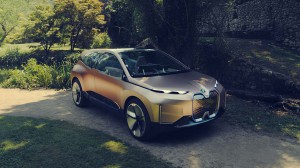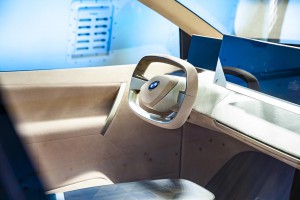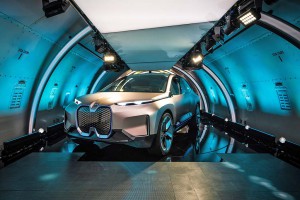
BMW offered a handful of journalists a sneak peek at the iNext concept during an around-the-world tour.
BMW was one of the first of the traditional automakers to enter the plug-in vehicle market, well ahead of luxury rivals like Mercedes-Benz, Audi and Lexus. But it has been slow to follow up on its original i3 and i8 models, especially when it comes to all-electric offerings, even as those competitors have laid out aggressive plans to launch literally dozens of their own new products in the coming years.
BMW has been dropping hints about where it might go next for several years. And the Bavarian automaker is looking to get back in the game with the appropriately named iNext, an all-electric and autonomous crossover set to make its debut in 2021.
A handful of select media outlets, including TheDetroitBureau.com, got a chance to check out a prototype version of the iNext during an otherwise top-secret, around-the-world series that took the concept vehicles from Germany to New York, then Los Angeles and, finally, Beijing.
(What happens when you already have an X1 through X7? BMW looks for still more SUV opportunities. Click Here for more.)
In its current form, the iNext concept is meant to push the limits, both in terms of design and technology, but it also offers a very real glimpse of where BMW sees itself heading over the next decade, according to Chairman Harald Krueger. “The iNEXT project,” he said, ahead of the prototype’s global tour, “will provide our building blocks for the future, from which the entire company and all of its brands are set to benefit.”
The iNext we got to look at aboard a specially modified Lufthansa 777F jet at New York’s Kennedy Airport is the spiritual and technological successor to the iVision Dynamics concept BMW unveiled barely a year ago at the 2017 Frankfurt Motor Show. There are clear similarities, starting with the laser headlights, as well as the narrower take on the brand’s familiar double-kidney grille. That reflects the need for far less air to flow into the engine compartment than you would have with a gas or diesel-powered vehicle, explained corporate design chief Adrian van Hooydonk.
The biggest change, of course, is that BMW has opted for a more SUV-like body with the iNext, a clear reflection of the massive shift reshaping the global automotive market. About the size of an X5, and significantly taller than the sports sedan-shaped iVision show car, BMW designers have had to put even more emphasis on wind-cheating design details in order to maximize both range and performance. That includes such details as the air curtains around the front wheels and the high spoiler lip atop the rear hatch.
As much effort as BMW put into the exterior of the iNext, however, van Hooydonk emphasized that, “This vehicle was designed from the inside-out.” That should be no surprise, and we’ve already seen Jaguar take a similar approach with its new I-Pace electric SUV. With electric propulsion, you can largely eliminate the engine compartment, mounting your battery and electric motors, instead, under the load floor. In turn, that’s space you can recapture for passengers and cargo,
In its current form, the iNext has an absolutely cavernous interior – closer to that of the upcoming X7 Sports-Activity Vehicle — and could readily squeeze in an additional row, offering occupants far more space than with the current, three-row X5. Instead, you get what is essentially a mobile living room – or, if you prefer, an office on wheels.”
“We want this to be your favorite space on four wheels,” the design chief suggested.
Occupants get a spectacular view of the outside world, incidentally, the windshield flowing well into the nearly all-glass roof. And there are no B-pillars to obstruct one’s vision.
(Infotainment technology finally getting better, reveals new JD Power report. Click Here for more.)
The technology inside the iNext offers some intriguing ideas, and more than a few surprises. For one thing, where other automakers have loaded up future concept vehicle with all manner of videoscreens, there are none for backseat occupants. They’re expected to connect their own mobile devices to the concept vehicle’s built-in WiFi.
And while BMW has made much of the gesture control technology built into new production models like the 7- and 8-Series, it’s notably absent from iNext. Instead, the automaker has come up with a way to build touch-sensitive controls into the jacquard fabric used for the rear seat. Trace a circle, for example, and it lights up using fiber optic pipes woven into the fabric, indicating how much you’re raising the volume of the show car’s sound system.
“We do things with a fingertip,” explained Dirk Muller-Stolz, one of the lead designers on the iNext project. “In a word, it magically comes to life.”
Another intriguing feature built into the iNext is dubbed the “Intelligent Beam.” It can project still or video images onto a sheet of blank paper and you can use the swipe of a finger to change “pages,” or control a video.
(Hey, BMW! Bavarian maker introduces new AI-enabled in-car assistant. Click Here for the story.)
There are two widescreen monitors in the front seat, both for the driver, replacing essentially all conventional knobs and buttons.
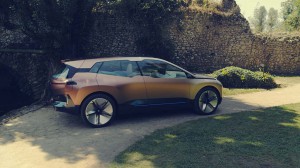
BMW isn't saying much about the underlying electric drive system but there are hints it could deliver M-Class power.
There’s also a squared-off steering wheel, but it is designed to retract into the instrument panel, the pedals sinking into the floor, when the iNext is switched into autonomous mode.
According to Klaus Fröhlich, the member of the BMW AG board responsible for R&D, “the car is capable of Level 4” autonomy, meaning it could operate entirely without a driver on many roads and in most weather conditions. The production version, he added, will likely have similar capabilities, though “the regulators will define” whether BMW might have to pair that back to Level 3 autonomy, where a human “operator” will need be ready to take over at a moment’s notice.
Either way, Fröhlich stressed, the car will retain the ability for manual control and, he promised, will still offer the sort of dynamic driving experience you’d expect from a BMW. But it will do so with an all-electric drivetrain, “battery-electric vehicles b eing the new normal for us.”
BMW isn’t offering specific details about that drivetrain, but does hint that it is targeting a range of around 600 kilometers, or nearly 375 miles, range between charges. The system, we were told, uses the fifth-generation BMW lithiumion battery technology. There is, as yet, no timetable for moving even further, to adopt the solid-state batteries that are expected to dramatically improve range, charging speed and pricing.
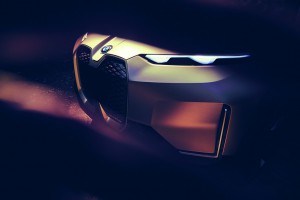
The distinctive nose on iNext reflects the need for less air inside the engine compartment but far better aerodynamics.
BMW was cagey about several other key details, including the basic material mix it will use to build the production iNext. Van Hooydonk hinted that it will likely be a mix of the carbon-fiber used for the i3 and i8 models, as well as aluminum.
While we know the autonomous and electric-drive systems will carry over into the production iNext coming in 2021, we’ll have to wait a few more years to learn more details about the rest of the technology that BMW will go with.
The shift from a sedan body to a crossover makes sense considering current market trends, said Sam Abuelsamid, a lead technology researcher with Navigant. But Abuelsamid said BMW will have to do some catching up as key competitors start rolling out electric vehicles of their own. Mercedes just debuted its new EQC battery crossover this month and will follow next year with the smaller EQA.
“BMW got in early but seemed to sit on their hands while they tried to figure out what to do next,” said Abuelsamid, though he added that the iNext could help put the Bavarian automaker back into the game.

